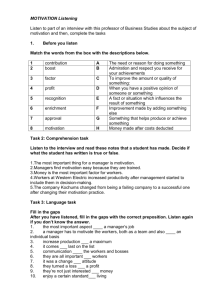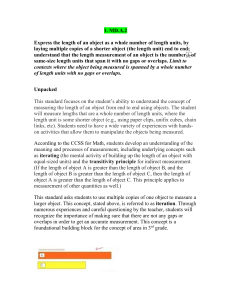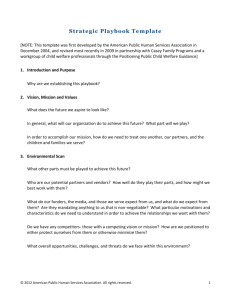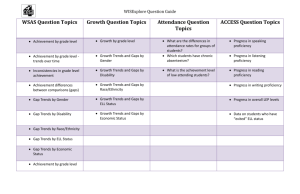Gap Analysis & Action Plan for International Sales
advertisement
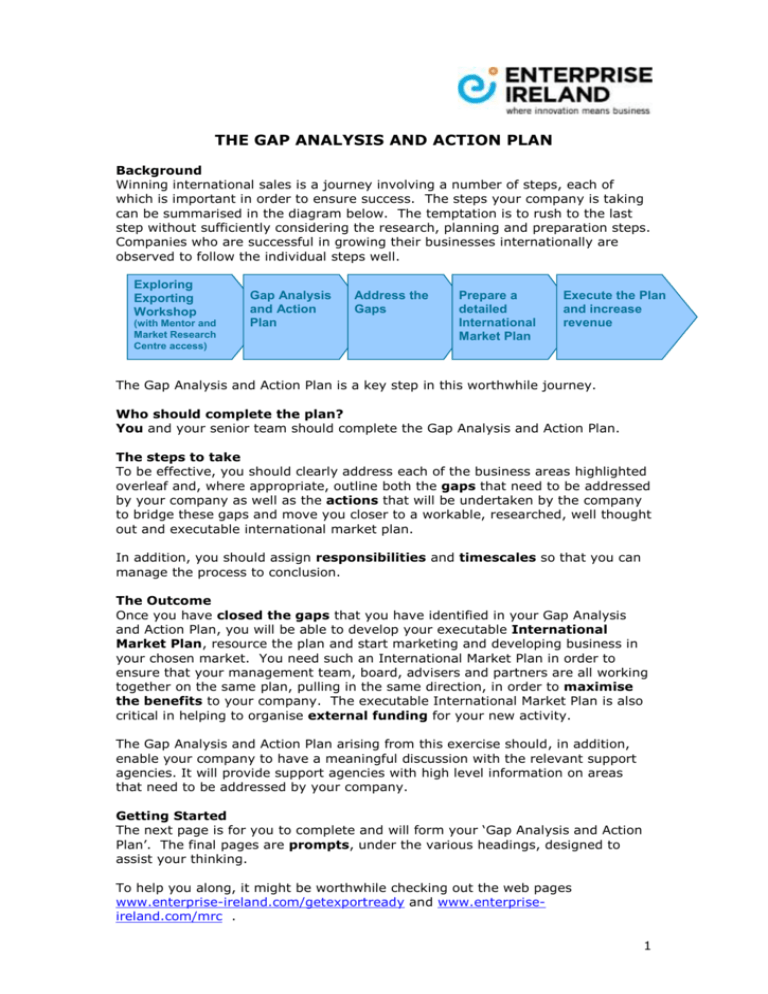
THE GAP ANALYSIS AND ACTION PLAN Background Winning international sales is a journey involving a number of steps, each of which is important in order to ensure success. The steps your company is taking can be summarised in the diagram below. The temptation is to rush to the last step without sufficiently considering the research, planning and preparation steps. Companies who are successful in growing their businesses internationally are observed to follow the individual steps well. Exploring Exporting Workshop (with Mentor and Market Research Centre access) Gap Analysis and Action Plan Address the Gaps Prepare a detailed International Market Plan Execute the Plan and increase revenue The Gap Analysis and Action Plan is a key step in this worthwhile journey. Who should complete the plan? You and your senior team should complete the Gap Analysis and Action Plan. The steps to take To be effective, you should clearly address each of the business areas highlighted overleaf and, where appropriate, outline both the gaps that need to be addressed by your company as well as the actions that will be undertaken by the company to bridge these gaps and move you closer to a workable, researched, well thought out and executable international market plan. In addition, you should assign responsibilities and timescales so that you can manage the process to conclusion. The Outcome Once you have closed the gaps that you have identified in your Gap Analysis and Action Plan, you will be able to develop your executable International Market Plan, resource the plan and start marketing and developing business in your chosen market. You need such an International Market Plan in order to ensure that your management team, board, advisers and partners are all working together on the same plan, pulling in the same direction, in order to maximise the benefits to your company. The executable International Market Plan is also critical in helping to organise external funding for your new activity. The Gap Analysis and Action Plan arising from this exercise should, in addition, enable your company to have a meaningful discussion with the relevant support agencies. It will provide support agencies with high level information on areas that need to be addressed by your company. Getting Started The next page is for you to complete and will form your ‘Gap Analysis and Action Plan’. The final pages are prompts, under the various headings, designed to assist your thinking. To help you along, it might be worthwhile checking out the web pages www.enterprise-ireland.com/getexportready and www.enterpriseireland.com/mrc . 1 My Gap Analysis and Action Plan GAP ANALYSIS What are your company’s gaps in preparing to internationalise? ACTION PLAN What actions will you take to close the gaps? Time frame and who is responsible? Export Market Knowledge Real Customer Problem Target Customer Groups Competitors Channels to market Managing Partners Culture in the market Marketing mix Customer Value Proposition Company Performance Financial Efficiency Capacity Product Processes & Procedures IP Protection (Product, service & brand) Management Team Functions People Skills Roles & Responsibilities Communication Funding you Growth Funding required Funding available 2 Helpful prompts to support your completion of the Gap Analysis and Action Plan Below are questions, under each of the main headings in the Gap Analysis and Action Plan, which are designed to help you think of all the aspects involved in becoming a successful international company. These questions should help you to identify the gaps in your knowledge, operations, product offering, systems, procedures, marketing, skills and experience that need to be addressed in order to achieve successful, and profitable, sales in new markets. Take one heading at a time and identify your gaps, then develop the actions that your team will undertake to close the gaps. Add in time scales and responsibilities to complete your Gap Analysis and Action Plan. This will give you a clear path to becoming ready to win sales in new markets and will improve your chances of success. Because this is your plan, it makes sense to be absolutely honest in your appraisal of your company’s performance. New Market Knowledge It is important when answering the following questions that factual evidence is used rather than the team’s perception. What is the real customer problem that your target industry is facing which your product is designed to fix? What is the problem at the industry level and can you define it more tightly at the level of the customer groups you are targeting? What evidence supports this? What are the customer groups that you will target in your chosen market? In your domestic market you may be targeting many customer groups but, because your new geographic market is likely to be much bigger, you can afford to target a more defined customer group. Being more focussed usually leads to better sales. Choosing which customer groups to target in the first instance evolves from your market research. Along with choosing customer groups, what geographic area are you going to target? Ireland has a population of less that five million. The greater Birmingham area in the UK has a similar population. If you tackle the whole of the UK you will be targeting a market twelve times bigger than Ireland, so it may make sense to narrow the geographic focus in the first instance to a size that your company can cover in depth. What are the purchasing criteria of your chosen customer group in terms of price, quality, delivery, availability, after-sales support, good working relationships? What is the buying process and who are the influencers and the decision makers? What gaps and opportunities exist? What evidence you to have to support your answers? What are the key current and emerging competitors that you will face when selling to your chosen target customer group? These may be different for different customer groups. How much do you know about the companies, their size and capabilities, their market share, their financial positions, their products and services, their channels of distribution and their access to customers? How well does your solution compare with the best of those competitors? Do you need to improve any aspects? What are the barriers to entry for other new competitors in entering this market and what is the evidence? 3 How big is the market opportunity, not just the overall market size but that portion of the market that you can realistically challenge for? Is it growing? What is driving that growth in the short term and also in the medium term? How does your company continuously build insights into your sectors ecosystem and trends? Where can you get the information you need? Enterprise Ireland’s Market Research Centre, www.enterpriseireland.com/mrc , has, in addition to key sector reports, a number of Country Guides. Having identified your customer group and your competition, what are the appropriate marketing and distribution channels to help you get your product sold and delivered to the customer? Do you have an excellent knowledge of the different types of channels? What is the profile you require from a channel partner? Who are the available channel partners? What agreement will you use? Who will develop the individual business plans with each partner and how will you manage their performance? How quickly can you respond to a non performing partner? What is the Value Proposition to these potential partners and how is it different to the Value Proposition to the end customer? What is the business culture in your chosen market and what do you need to put in place in your company to account for it? Include issues such as language (words, phrases and use of colloquialisms), behaviours, holding of business meetings, changes needed to company and product presentations and their style, use of first or last names, style of greeting used and use of business cards. Do you have detailed knowledge of all the regulations and standards that apply in your chosen geographic market and with your target customer group? Include product, production, waste and safety regulations and standards? Are their specific standards that individual customers will require? The Marketing Mix covers price, place, product and promotion. Is your current product or service the correct one for your chosen market? Does it need to be modified or does a new product need to be developed? What are the acceptable prices in your sector and do they include allowances for currency differences and associated costs such as reps or agents, shipping/distribution costs, promotional costs and take account of the value added importance of the product? What is the evidence? What is the best way for you to promote your company and its product/service to your target customer group? Have you thought through the different methods available to you and their associated costs? Remember you need a budget for these activities – see below. Has your company a differentiated Customer Value Proposition? Have you segmented your target customers by buying decision in terms of their customer pain/your value? Have you involved current customers in developing your CVP? Do you regularly re-appraise if your offer has uniquely differentiated benefits compared to the competitors? How regularly and who do you involve? Do you need to distil and communicate multiple propositions and how will you manage this? (Note that Enterprise Ireland’s Market Research Centre has many valuable market information reports that can be accessed, click here. For companies in the food sector, Bord Bia also has additional reports, click here). 4 Company Performance There are a number of areas of company performance worth looking at in relation to starting to export. The first is the current financial performance of the company. Does the company operate to a rolling two to three year business plan? Does the company produce timely annual, and in some cases, audited accounts and more regular management accounts? Does the company regularly achieve its yearly sales and profitability targets? Is the company very dependent on two or three customers? What share of the domestic market does the company have? Is profitability near the top of your sector’s norm? Does the business generate cash which could be used to support exporting? Is your production process or your service process as efficient as your best competitor, or as efficient as it could be? Improved efficiency increases your margin as well as the cash that is generated and available to support exporting, so it makes sense to look at increasing efficiency before exporting. Service and software businesses can benefit from efficiency improvements just as well as traditional manufacturing companies. What is your production/service delivery capacity situation? Does capacity ramp up in line with sales generated or does capacity have to be increased in large steps? Do new staff have to be trained for a short or long time before the company can increase quality output? Does your recruitment process allow for the rate at which you may have to increase staffing levels? This applies to software and services companies as well as production companies. Does the company have the right product or service for the new market? Does a new product or service have to be developed? Do I have the people and processes to achieve this? Does my existing product just need a few small refinements rather than developing a new product? Do I have the necessary copyright or patent protection? Are my processes and procedures sufficiently robust, and appropriate for this export market? Are they stretched to breaking point already? Are they systematised and formalised? Can I ramp up my lead generation activity to meet the need? Do the right staff meet frequently enough to really qualify the leads? How do I make the decision as to which target customers I will allocate my staff? How do I build our knowledge of the target customers to see if they are worthwhile pursuing? Do I have a systematic and repeatable sales process? How do these processes need to differ in my new market? How do I find out if the target customer has a budget and a project running now or in the near future? How do I make the decision to temporarily stop chasing a customer in favour of allocating my resources to other target companies? How do I identify, select and manage market partners? Do I manage partners in a formal manner, collecting weekly and daily information that keeps me informed of progress and hosting weekly/fortnightly calls? Do I have an efficient logistics operation in place that can take on the expected increase in activity? 5 Management Team Is the whole management team agreed on the strategy going forward or does further work need to be done to achieve agreement? Does the company have all the necessary functional skills covered at management level? These can include the CEO function, sales, marketing, new product development, production, logistics, accounting and human resources. In smaller companies, many of these functions are carried out by one or two people, but it is still a good idea to think about each function separately. Does the company have the skills at international level so that the company can grow with confidence in new markets? Where can the company get the missing skills? If you have to hire new skills do you have a thought out recruitment process in place? Can you get these skills on a temporary basis before taking them on long term? Is there true clarity of roles and responsibilities among the management team? Which senior manager has been given responsibility, and space, for ensuring the success of the new market activity? How do you continuously communicate internally and bring your staff with you as the company changes and grows? If you have a board, does it have the right balance of skills and experience to help guide the company successfully into export markets? Is there a need for additional advisers to come in on a short term basis to close out gaps in skills or experience? How might you get them? Funding What funding is required to sustain the business through its growth in new markets over the next three years? What funding will come from the existing business and what is the gap that needs to be filled? What is the whole range of options available to your company to fund the gap? Do I need specialist input to help develop the projected cash flows and financial projections? Do I know all the types of trade finance available to me? What Value Proposition do I have for the funders and does it differ for different funders? What are all my underlying assumptions and are they correct? Examples of such assumptions might include: What is a reasonable time to go from contacting the first customer to getting first revenue? How does the cash cycle work in this market and how is it different to my existing market? What exchange rate should I use? What contingencies should I allow? Congratulations. You should now have a sound action plan to help your company prepare successfully for international markets. 6
